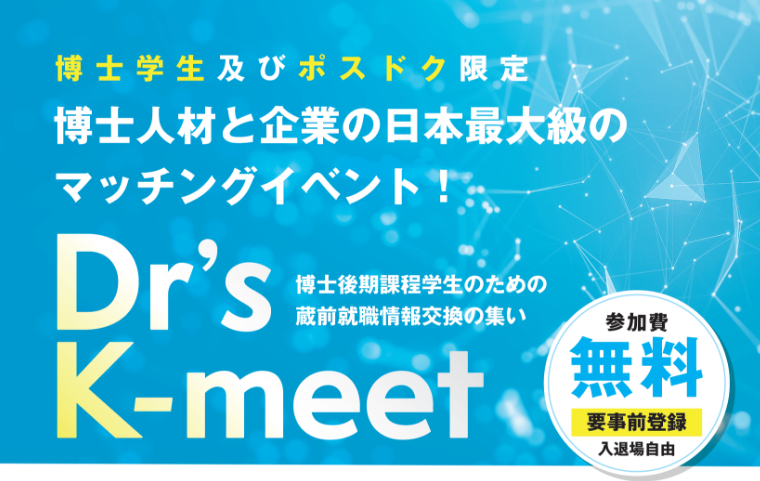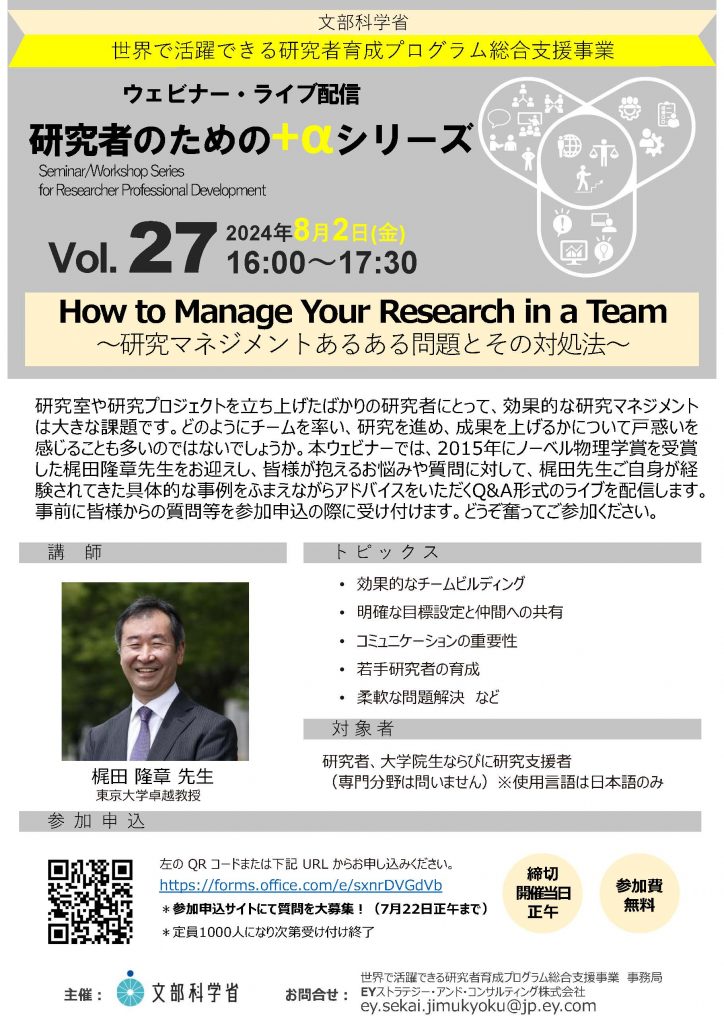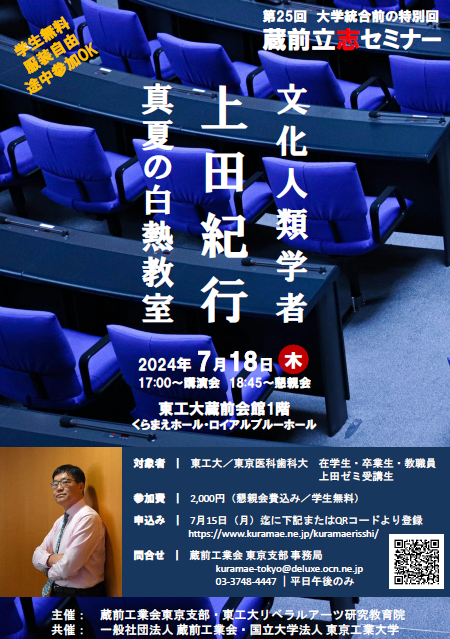Interview No.23 QI Chao
School of Engineering
I come from Ningbo (寧波), a coastal city in China. After graduating from undergraduate program in China in 2018, I came to Tokyo Institute of Technology to pursue my master’s program. Now is my third year of PhD and I just finished my midterm defense in the Department of Mechanics last month. My hobbies are hiking and cycling. I usually go to the gym on weekends to exercise to relieve stress.

研究概要 / Research Outline
My research focuses on electromagnetic MEMS, specifically electromagnetic soft micro-actuators. Compared to traditional rigid actuators, soft actuators are more flexible, safer, and more biocompatible, making them particularly suitable for use in wearable devices and medical robotics. Currently, the most common way to drive soft actuators is through electrostatic actuation since structure of the actuator is simple. However, thousands of volts are usually applyed to two electrodes to drive the actuator, which makes the whole system not only requires a voltage boosting module but also not safe.
Therefore, I would like to develop an electromagnetic soft micro-actuator, as it can be directly driven by a battery. The most important part of an electromagnetic actuator is a composite material consisting of a soft polymer material (e.g., PDMS) and a permanent magnet functional material (e.g., NdFeB), which can deflect under an external magnetic field. The challenge of my research is that it is difficult to integrate the permanent magnet functional material onto the polymer using MEMS technology. This is because most polymer materials are insulating and not heat-resistant, and the current way of manufacturing magnets using MEMS technology is through electroplating or high-temperature physical vapor deposition.
Therefore, I propose to use new materials and new technologies to develop electromagnetic soft micro-actuators. First, I integrated NdFeB bonded magnets into a PDMS film. As the manufacturing temperature for bonded magnets is relatively low, I simplified the manufacturing of the composite material. Then, to improve manufacturing accuracy, I printed conductive polymer composites onto the PDMS film to form an electromagnetic coil to manufacture a moving-coil-type actuator. Because screen printing has been used in manufacturing, printing accuracy was greatly improved. Finally, to create an electromagnetic soft actuator with a simple structure similar to electrostatic ones, I proposed an actuator that uses only one FePt material. FePt acts as both a soft structural material and a permanent magnet functional material, greatly simplifying the structure of the electromagnetic soft actuator.
Cross-many-borders off-campus study
My off-campus study is different from one of most people who spend a long period in the same place. I attended conferences, conducted off-campus experiments, or visited some academic institutions in six locations last year.
In last june, I visited the laboratory of Dr. Nora Dempsey at the Institut Neel in Grenoble, France. Dr. Dempsey and her students mainly introduced the basic fabrication, characterization, and application of sputtered NdFeB magnets for magnetic MEMS in medical applications. I started to know better about the triode sputtering technology they developed. At present, few magnetic MEMSs are commercially available, mainly due to the inability to obtain large-area uniformly deposited magnets, and the inability to obtain thick-film (>100 μm) high-performance anisotropic NdFeB magnets. The triode sputtering technology can now produce smooth high-performance NdFeB magnets on a 4-inch silicon wafer, and they have also achieved the fabrication of 150 μm high-performance NdFeB magnets. In addition, I learned one high-throughput magnet characterization equipment they developed. For the characterization of magnets with different compositions, we often need to make magnets with different compositions and then characterize them separately. However, the device they developed (Magneto-optic Kerr effect device) allows researchers to know the properties of magnets with different compositions and different heat treatments very quickly, which will greatly reduce the material development time. In addition to the two study topics mentioned above, we also learned about bonded magnets, thermo-magnetic-patterning, magnetic actuators made by 3D printing, and the biological and medical applications of magnets.
Still in last June, I attended the three-day Actuator 2022 international conference in Mannheim, Germany, to present my research on disposable, high-pump-density electromagnetic membrane pumps for high-speed PCR amplification chips. During the conference, I also watched others’ presentations and posters and gathered information about micropump such as gear-driven and magnetic shape memory based pumps. By participating in this conference, I gained a new understanding of presenting in English, how to better answer questions in the conference, and collaborative research. First of all, this was my first time to attend an international conference outside of Japan, so I realized that my academic English speaking skills are still not good enough when I participated in other people’s presentations. As a result, I have to learn to improve this ability in the future. During the Q&A session of my research presentation, when chairman prompted me that my answers could be open-ended, I realized that my own previous answers were always either/or. Therefore, I will be more open-minded to the research in the future. In particular, I noticed that a lot of good research is produced through collaboration, so I hope to be able to conduct collaborative research in teams by contributing my expertise in the future.
In last July, I visited Mr. Tim Bierewirtz (a YSEP exchange student at Tokyo Tech three years ago) at Charity-University Medicine Berlin in Berlin, Germany. He gave us a tour of the school and showed us his lab and his latest research. We visited his lab and heard a lot about practical medical-related research. I was most impressed by two studies. One of them was to set up several dummies in a room and investigate the effect of human position on the propagation of COVID-19 by actual measurement, which is very practical because it is different from most research using simulations nowadays. The other study is about the development of a total artificial heart promoted by a German-Swiss-Austrian consortium that can be used for patients with damaged hearts. All of their studies are practical because their lab is affiliated with the hospital, and they can conduct medical experiments more easily compared with many other mechanical engineers. I had a discussion with Mr. Bierewirtz about future research collaborations. I would like to use the micropump developed in my work to complete rapid PCR amplification at Charity-University Medicine Berlin.
In last October, I was working with Prof. Nakano in Nagasaki University about FePt magnets based on pulsed laser deposition method. Previously since the magnets were provided by Prof. Nakano’s lab, I did not understand the processing and evaluation of the magnets very well. I spent two weeks in his lab learning about magnet processing and evaluation in order to better understand the processing steps and manufacturing difficulties of magnets. I learned how to fabricate FePt film magnets using a pulsed laser deposition method, and I also learned how to use vibrating sample magnetometer, scanning electron microscope, and heat treatment machines. In the conversation with Prof. Nakano, I also learned how to make anisotropic magnets with higher performance by using substrate heating method.
In last November, I attended the Asian Society for Precision Engineering and Nanotechnology conference (ASPEN2022) in Singapore and presented my research of fabrication of flexible coil on PDMS for MEMS-based electromagnetic membrane actuator. I increased my experience of presentation in English abroad, and I improved my presentation skills through the publication Q&A sessions. I also participated in the Young Research Night to meet researchers in Asia and expanded my academic circle. At the same time, I visited Dr. Christopher Lee’s lab at Nanyang Technological University. He and his students introduced their research about the electric motors. After visiting Lee’s lab, I gained a good understanding of the research institutions in Singapore. Unlike the professor/associate professor-centered labs in Japan, the PI of a research institution in Singapore can be an assistant professor.
In last December, I attended the Micro and Nanotechnology for Power Generation and Energy Conversion Applications (PowerMEMS2022) in Utah, USA. I participated in the presentation and poster sessions and found that electrostatic energy harvester is currently the most common one in energy harvester due to its simple structure. I also had a poster session where I presented my new research on the magnetic membrane actuator, which is research to simplify the structure of the magnetic transducer. During the poster session, I also exchanged ideas with peers and actively looked for opportunities to collaborate. The conference also gave us a tour of the nanofab center at the University of Utah, where I learned some new MEMS evaluation instruments. Through this conference, I realized that to make good research, I need to have a good background investigation, otherwise all the research is meaningless. At the same time, finding problems in the research is more important than doing research. During the conference, I presented my research in detail to Dr. Kevin Chen from MIT and Prof. Edwar Romero-Ramirez from Florida Polytechnic University and pointed out that my research could be helpful in their research to solve their problems. Dr. Kevin Chen said he would like to use our material and developed technology after our final evaluation. Prof. Edwar Romero-Ramirez said that he would like to miniaturize his current device with our newly developed technology and materials in the future.
Although I mention a lot of details here, what I want to express is that I learned different things and met different people inside different experiences. This really has made me a cross-border doctoral student. These different off-campus experiences have enhanced my perspective and opened my mind. Therefore, I think it is also worth trying to participate in different off-campus studies.


メッセージ / Message
People-to-people communication and cooperation among different nationalities is the basis of off-campus study and joint research, and peace is the major prerequisite for communication and cooperation. Therefore, let’s cherish the peace in front of us.



